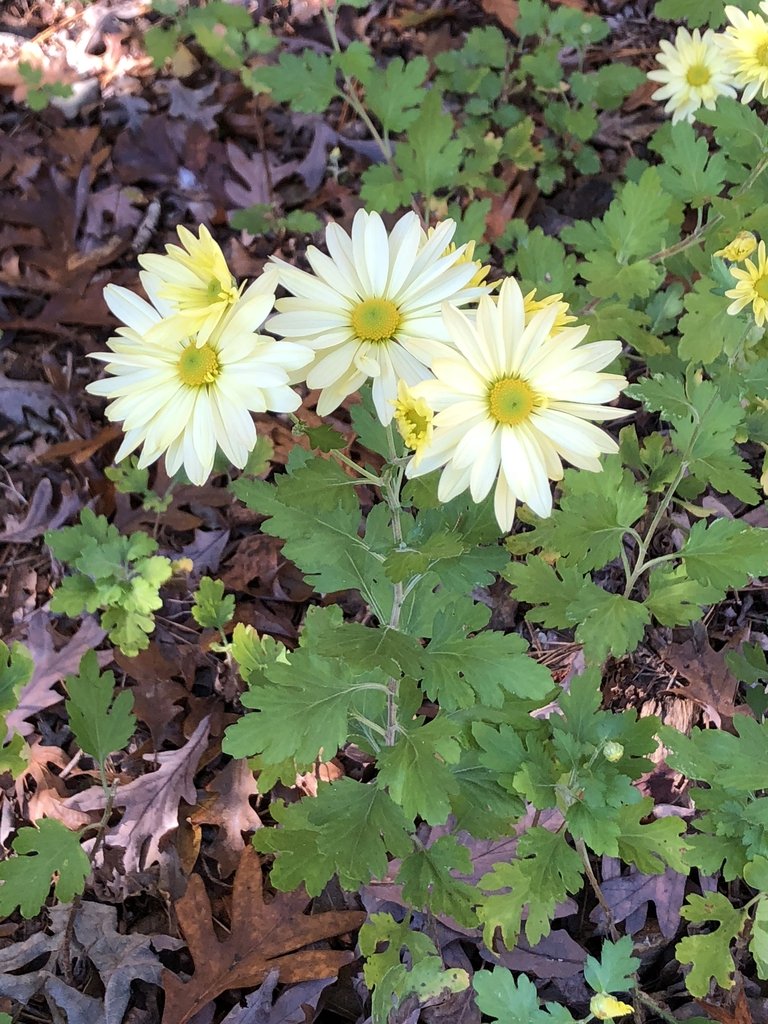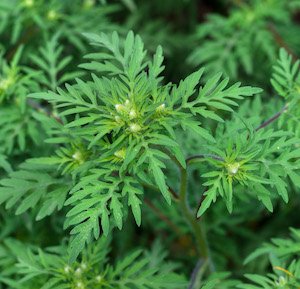Croneswort: Identification, Uses, and Preparations
I recently made an Instagram post in which I sung the praises of mugwort (Artemisia vulgaris), also known as croneswort.
Since then, I have had multiple inquiries about how to identify, acquire, and use croneswort, so I thought I would do a whole blog post about it! This will be the first in a series of posts about different herbs that are a part of my herbalism practice.
In this post, I will offer the following information:
How to identify croneswort.
Traditional medicinal and magical uses of croneswort, as well as contraindications for who should not use croneswort.
How to use croneswort.
How to acquire croneswort if you cannot find any to forage (spoiler: you can check out our shop to find homegrown croneswort and the wide variety of products that I make from croneswort!)
I would like to offer at the onset two disclaimers:
I will be sharing knowledge from my study and practice of herbalism, but please be discerning and detail-oriented. Do NOT harvest or use herbs unless you are 150% certain that you have identified them correctly.
I will be sharing how croneswort has been traditionally used. This should in no way take the place of seeking the care and guidance of a medical doctor, and it is not intended to diagnose, treat, cure, or prevent any diseases. Herbal care can provide incredible healing stimulus to the body, but should not be a replacement for care from your primary care physician.
With that out of the way, let’s get right to it!
Mugwort/CronesWORT IDENTIFICATION
Croneswort is a herbacious perennial in the the daisy family, Asteraceae. It grows in US growing zones 4 through 8 in all types of soil, including very poor soil quality. It spreads easily, and is often considered an invasive weed due to its root structure of branched rhizomes.
Because it spreads so easily, there is a good chance that it is growing in your yard or community if you are in one of its growing zones. If you have sections of your yard that annoy you with how frequently they tend to fill up with weeds, look at the weeds more closely to see if any of them are croneswort!
Croneswort grows on tall stalks that can reach up to 6 feet in height. It’s leaves are alternate (in other words, they are “staggered” up the stem, rather than two leaves growing directly across the stem from each other). The leaves have 3 or 4 pointy lobes with jagged edges.
Make it stand out
One of the main distinguishing features of croneswort is that the leaves are deep green on the top, but are whitish on the bottom due to tiny wooly hairs that grow on the bottoms of the leaves.
If it is in flower, it will have clusters of tiny cream-colored or yellowish disc flowers.
Be aware that croneswort can look similar to its relatives chrysanthemum (pictured below on the left) and ragweed (pictured below on the right). Note that ragweed’s leaves are more fernlike and are lacking in croneswort’s telltale white wooliness on the bottom. Chrysanthemum has more similarly shaped leaves to croneswort, but again they lack the whiteish wooly bottom side; chrysanthemum’s flowers are also very different from croneswort’s, so they’re easy to tell apart when they’re in flower!
MEDICINAL AND MAGICAL USES OF MUGWORT/Croneswort
Croneswort has several medicinal “actions,” or properties:
Anthelmintic: Helps expel parasites and parasitic worms
Bitter: Positively affects digestive and liver function
Cholagogue: Stimulates the flow of bile from the liver
Diaphoretic: Stimulates perspiration, helps with peripheral vasodilation of the sweat glands (very helpful at the onset of colds)
Diuretic: Increases the output of urine from the body; helps minimize fluid retention
Emmenagogue: Helps to initiate menses
Nervine: Calms/balances the nervous system
Stimulant: Enlivens the body’s physiological processes
Croneswort has traditionally been taken to ease the symptoms of menstruation (including cramping and bloating) and menopause (including minimizing the frequency and intensity of hot flashes), to soothe pains associated with childbirth, to help with stomach disorders including alleviating nausea/diarrhea/constipation and improving appetite, to minimize symptoms of depression and anxiety, and alleviate fatigue and sleep disorders.
Topically, croneswort oil can help ease aching muscles and itchy skin due to its high magnesium content. It has even traditionally been placed in people’s shoes to prevent foot pain. It also acts as an insect repellant!
In traditional Chinese medicine, it is used for moxibustion.
It has also been used for a wide variety of spiritual and magical uses, including:
Protecting against harmful forces and energies
Bringing forth psychic intuitions, divination, and prophetic dreams
Encouraging lucid dreaming and astral travel
Smoke cleansing (an excellent way to minimize the overharvesting of white sage and for non-First Nations/non-Native American folks to smoke cleanse spaces without engaging in the cultural appropriation of smudging)
Increasing one’s intuition
Croneswort should NOT be used by people who are pregnant; because it stimulates menses, it can result in miscarriage. (Related note: while it is safe to use by those who have heavy flow periods, please be aware that consumption of croneswort in the days prior to and during your menses may result in an even heavier flow).
It is also contraindicated for those who are breastfeeding/chestfeeding and for those who have significant allergies to ragweed.
HOW TO USE Mugwort/CronesWORT
Tea/infusion
Fresh or dried croneswort can be prepared into a tea by adding a cup of hot water (approximately 190 degrees Fahrenheit) to either 1-2 teaspoons dried store-bought croneswort, 1 T dried homegrown croneswort, or 2 tablespoons fresh croneswort and allowing to steep for 20 minutes while covered before straining.
When I make herbal infusions, I cover the pan with an inverted lid that I place several ice cubes on. The combination of the lid and the cold from the ice cubes ascertains that all of the herb’s oils that would otherwise be released through the steam will instead condense on the lid and return into the infusion.
Vinegar tincture
Making a croneswort vinegar tincture is an excellent way to extract its high mineral content (including calcium and magnesium) for ingestion (see the next bullet point, topical salve/oil, for extracting the minerals for topical use). You can use herbal vinegars in your salad dressings and recipes, which can make them a delicious way to invite the benefits of herbs into your life!
To make croneswort vinegar, be sure to use dried croneswort; fresh herbs can introduce too much water into the concoction, which significantly reduces its shelf life and could eventually lead to the growth of mold.
Once you have the dried herbs (if you want, you can add other high-mineral herbs such as dandelion and/or nettle; you can even add some chilis if you want to give your vinegar a bit of a kick!), place them in a sterilized mason jar and completely cover with either apple cider vinegar, balsamic vinegar, or rice vinegar. Cover the jar: if you are using a metal lid, be sure to place a circle of wax paper between the jar and the lid to prevent corrosion of the lid by the vinegar.
You will then place the jar in a dark closet for 4-6 weeks. After the desired amount of time has passed, press and strain the herbs, place the strained vinegar into a new sterilized jar with a non-corrosive lid, and label it with the date and the herb(s) used in it.
Herbal vinegars made with dried herbs can last for up to a year, especially if they’re refrigerated; making the vinegars with fresh herbs or storing the vinegar at room temperature may decrease its shelf life.
Topical salve/oil
Croneswort oil and salve are wonderful for alleviating muscle aches (while simultaneously acting as an insect repellant!).
To prepare croneswort, you can either macerate the herbs and allow them to steep longer (a month or so), or you can use very light heat from a crockpot or double boiler to hasten the process. My crockpot tends to run hot, so I just stick with the maceration process.
When making herbal oils, it is definitely best to utilize dried herbs: you do NOT want to end up with rancid oils due to the moisture in fresh herbs.
You would then macerate the herbs in a Vitamix, blender, or food processor with whatever oil(s) you’ll be using: common choices are extra virgin olive, jojoba, coconut, almond, and sunflower. I was taught to use only enough oil during the maceration process to create a pesto-like texture.
Then, place the “pesto” in a sterilized mason jar and add enough additional oil to fully submerge the herbs, plus an additional 1-2” of oil above the level of the herbs. After labeling the jar, place it in a dark place for about a month.
After the steeping time is complete, slightly warm the oil, and then strain and press the herbs through tightly-woven cheesecloth.
You can use this oil as-is, or you can take the additional step of blending it with a melted solid wax or butter, usually either beeswax, shea butter, and/or cocoa butter. This is a little bit more of an involved process, so I’ll leave the details of salve making for another post: stay tuned!
Alcohol tincture
Alcohol tinctures are made in a very similar way as vinegar tinctures. Two main disadvantages of alcohol tinctures are:
You will lose out on the helpful minerals within croneswort, as alcohol tinctures are not effective at extracting minerals from herbs. If you are interested in getting all of the benefits from croneswort’s calcium and magnesium, it is better to make it as a tea or a vinegar.
It contains alcohol. Although the alcohol content can be significantly reduced by placing your tincture into a cup of boiling water and then drinking the water/tincture combo once it has cooled, there are many people who want or need to completely avoid all alcohol consumption; alcohol tinctures would not be appropriate for them.
However, the alcohol tincture will be very effective at extracting the oils from croneswort, and it will have a longer shelf life than the vinegar tincture. There are pluses and minuses to every herbal preparation!
To make an alcohol tincture of croneswort, follow these steps:
Measure your herb by weight. You can use either fresh or dried herbs.
If using fresh herbs, add twice the volume of 50-60% ethanol alcohol (I use pure grain alcohol that I dilute with an equal amount of water) as the weight of the herbs: e.g., for 4 ounces of fresh croneswort by weight, add 8 fluid ounces of alcohol solvent. For dried croneswort, add four times the volume of 50-60% ethanol alcohol as the weight of the herbs: e.g., for four ounces of dried croneswort, add 16 ounces of alcohol solvent.
Place croneswort and alcohol in a mason jar. Cover; if using a metal lid, place a piece of wax paper in between the jar and the lid. Clearly label the contents and date.
Place the jar in a dark place (a closet or cabinet work great); shake several times a week (or up to daily) for about a month.
Strain and press the herbs. Store in an amber glass bottle, clearly labeled with the content and date.
To use, decant some of the tincture into a small dropper bottle. You can take a dropper- of tincture one to three times daily.
Dream pillow
This is one of the easiest preparations of croneswort! To promote vivid dreams, prophetic dreams, astral projection, and intuition and to repel negative energies while you sleep, hang some croneswort by your bed or place it under your pillow. You can also combine it with other herbs that promote restful sleep, such as lavender and chamomile.
Smoke cleansing
You can use wrapped bundles of dried croneswort in the same way as you would wrapped bundles of dried sage. White sage is incredibly overharvested, and it is important for non-First Nation people to minimize their usage of it so that it can be available to those for whom it is an essential aspect of their traditions and teachings. Because croneswort is so widespread, it is preferable to harvest it instead of the over-harvested white sage, and because it has wonderful and powerful cleansing powers, it can be used to very similar effect.
(Please note that if you do not want vivid dreams, it is best to avoid smoke cleansing with croneswort in the hour or so before you go to sleep).
Smoking
Dried croneswort has traditionally been added to smoking blends to promote relaxation, intuition, spiritual guidance, acceptance of the changes and rhythms of life, and dream recollection.
Please note that smoking any type of substance can result in a an accumulation of tar in the lungs; if an adult does choose to smoke herbs for medicinal and/or spiritual reasons, they should do so sparingly.
HOW TO ACQUIRE Mugwort/CronesWORT
If you live within croneswort’s growing zones, you may be lucky: it might be growing right in your yard or in nearby parks! You can refer to the above section regarding how to identify croneswort and go on a scavenger hunt! The leaves are best harvested prior to flowering, but it is still okay to harvest slightly after it has begun flowering.
(Do keep in mind that gathering herbs by highways or heavily polluted areas is not recommended.)
If you don’t live within croneswort’s growing zones, or if you do but you cannot locate any that is growing in a space that isn’t heavily polluted, you can purchase it through herbalists, witchy stores, or online through Etsy vendors.
As a shameless self-promotion, I almost always have some of my homegrown dried croneswort available for sale, either loose or in bundles for smoke cleansing; I also occasionally have croneswort vinegar, oil, and salve available for purchase, as well as tea blends that include croneswort. Check out our shop to see what we have that is made with mugwort/croneswort!
SOURCES:
Chestnut School of Herbal Medicine’s textbook for the Herbal Immersion Program





